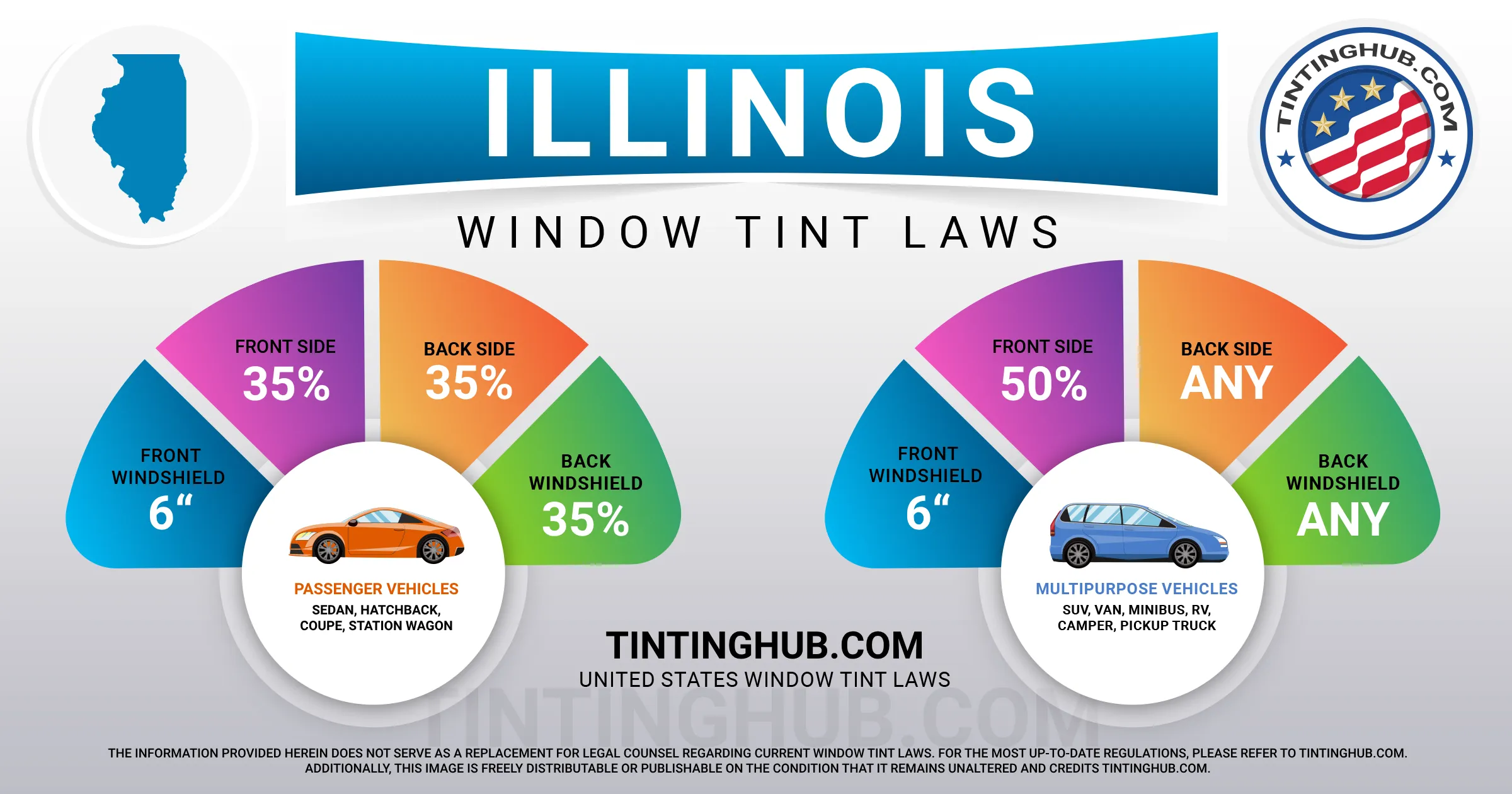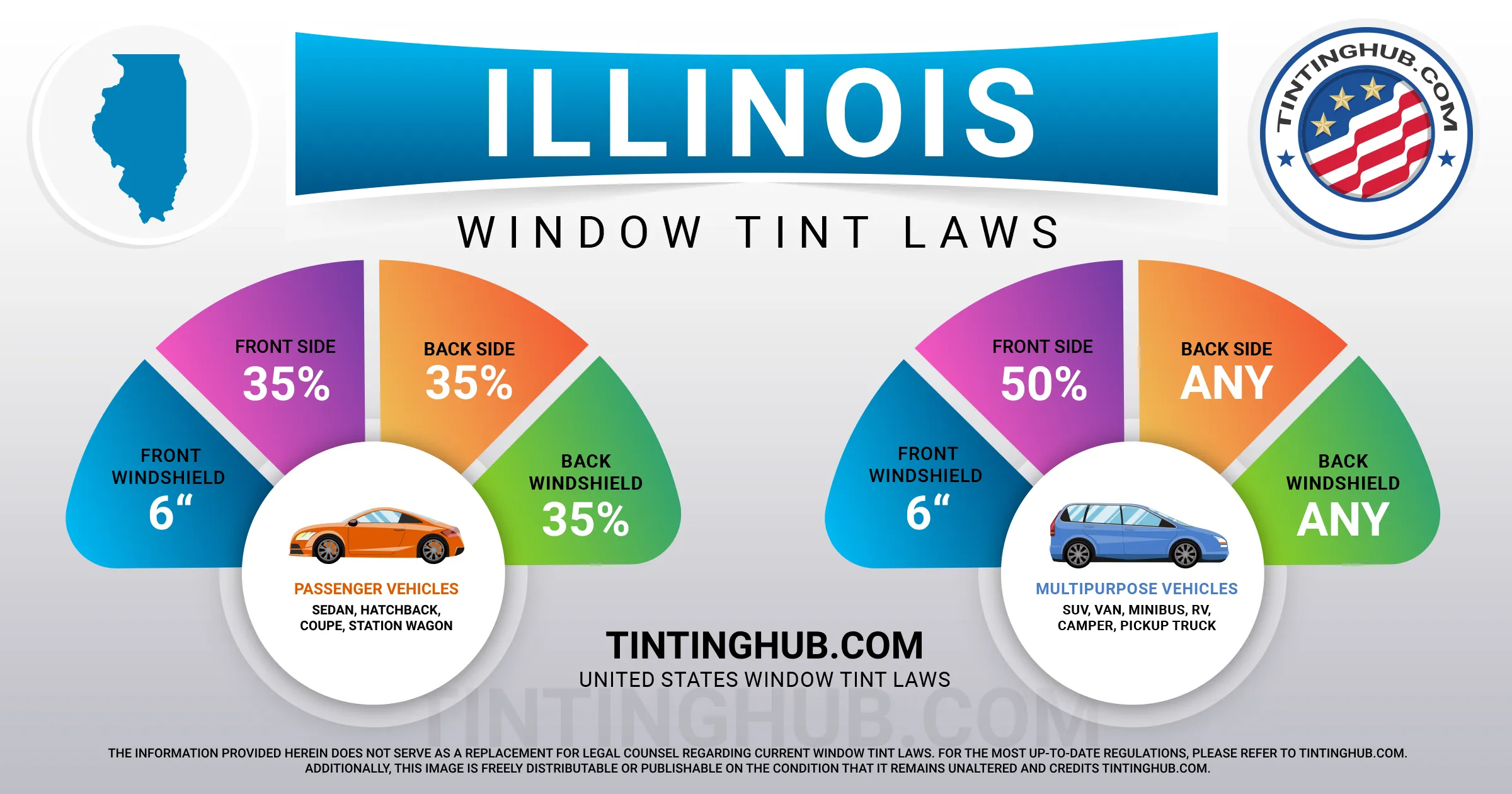Illinois Window Tint Laws (Last Update 2024)

Are you an Illinois resident looking to add a touch of style and comfort to your vehicle with window tinting? Understanding the car window tinting laws in Illinois is crucial to ensure your ride remains both legal and stylish. In 2009, Illinois introduced stringent regulations regarding window tinting, and we’re here to provide you with all the essential information you need to know about these laws. From tint darkness to reflection rules and additional regulations, we’ve got you covered. Let’s delve into the world of Illinois window tinting regulations.

Window Tint Darkness in Illinois
Sedans’ Tint Darkness:
When it comes to sedans, Illinois has specific regulations for the darkness of window tint:
- Windshield: Non-reflective tint is allowed on the top 6 inches of the windshield.
- Front Side Windows: These windows must allow more than 35% of light to pass through.
- Back Side Windows: Must allow more than 35% of light in.
- Rear Window: Must allow more than 35% of light in.
SUVs and Vans’ Tint Darkness:
For SUVs and vans, the regulations vary slightly:
- Windshield: Non-reflective tint is allowed on the top 6 inches of the windshield.
- Front Side Windows: These windows must allow more than 50% of light to pass through.
- Back Side Windows: Any darkness can be used.
- Rear Window: Any darkness can be used.
Illinois stands out with its unique window tinting laws that allow for more flexibility, such as installing 35% VLT on all windows (except the windshield). However, there are some conditions to keep in mind:
- All windows behind the driver can legally have any tint percent, but only if the front side windows are not tinted.
- Front side windows may have 50% light transmission, but only if no window behind the driver is tinted under 30% VLT.
- On vehicles with factory-installed window tint of any darkness on any back window, front side windows must have over 50% VLT.
Window Tint Reflection in Illinois
Window tint can do more than just enhance your vehicle’s aesthetics; it can also reduce glare and heat. Illinois window tint law permits a certain window reflection when using tint, so it’s essential to pay attention to this aspect as well.
Sedans’ Tint Reflection:
- Front Side Windows: Must be non-reflective, and state law is not specific about what this means.
- Back Side Windows: Must be non-reflective.
SUVs and Vans’ Tint Reflection:
- Front Side Windows: Must be non-reflective, and state law is not specific about what this means.
- Back Side Windows: Must be non-reflective.
Other Illinois Window Tint Rules and Regulations
Apart from tint darkness and reflection rules, Illinois has several other essential laws and regulations related to window tinting:
- Side Mirrors: Dual side mirrors are required if the back window is tinted.
- Restricted Colors: Illinois tint laws do not explicitly ban any colors of tint.
- Tint Variance: A 5% variance is allowed.
- Certificates: Manufacturers of film do not need to certify the film they sell in the state.
- Stickers: There’s no requirement for a sticker to identify legal tinting.
- Medical Exceptions: Illinois allows medical exemptions for special tint. For specific terms of the exemption, consult your state law.
Penalties for Non-Compliance
It’s essential to adhere to Illinois window tinting regulations, as there are penalties for non-compliance. Violating these regulations can result in penalties that range from a petty offense with a fine of $50 to $500 for the first offense, and for second or subsequent violations, it becomes a class C misdemeanor with a fine ranging from $100 to $500.
Local Interpretation
Please keep in mind that your county or place of residence may interpret Illinois tinting laws and regulations differently. Therefore, it’s always a good practice to double-check the information with your local DMV or law enforcement authorities to ensure you remain in compliance.
Conclusion
Our information about window tint laws in Illinois is up-to-date as of 2023. However, laws and regulations can change, so if you notice any discrepancies or have any concerns, please feel free to contact us. We are your trusted industry leader in providing accurate and reliable information on window tint laws, ensuring that your vehicle remains stylish and street-legal.